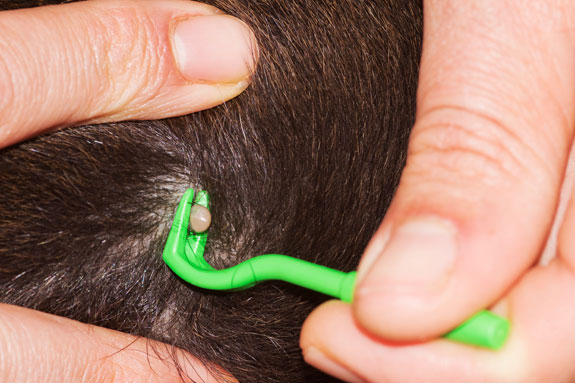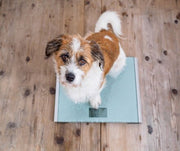Ticks In Dogs: A Step-by-Step Removal Procedure

Ticks In Dogs: A Step-by-Step Removal Procedure
Ticks are spider-like, egg-shaped, blood-sucking insects that can affect both dogs and humans. This eight-legged creature varies in size, from about 1mm to 1cm long, and can be black, brown, or tan. It is vital to remove ticks as soon as you find them on your dog as these creepy crawlers carry microbes that cause diseases such as Lyme disease and Babesiosis. They are very good at passing on infections from one animal (or human) to another, and feed by feasting on animals' blood for days. While ticks don't fly or jump, they do climb or drop on to your dog's coat whenever you brush past the area they are sitting in.
Below are some tips to spot and remove a tick from your dog:
SPOT THE TICK
1. Ticks are big enough to spot. Consider giving your dog a once-over before you go inside the house to lower the chances of bringing ticks inside your home.
2. Start by running your fingers slowly over your dog's body.
3. If you feel a bump or swollen area, check closer and part your dog's fur to see if a tick has burrowed its way in there. You can find ticks in these common areas:
- Torso
- Between their toes
- Around or under arms and legs
- Inside the ears
- Around the face, neck, or chin area
TICK REMOVAL TIPS
There are various ways to remove a tick from your dog. According to the Center for Disease Control and Prevention (CDC), you need a physical tool to remove ticks properly. Specifically, a pair of tweezers or a specially-designed tick removal tool. The tools are designed to extract the tick's mouth and head from beneath the skin without breaking them off. In other words, it removes them alive.
Below is a step-by-step procedure to ensure a safe tick removal using tweezers or a tick removal tool.
PREPARE YOUR EQUIPMENT
You'll need:
- Latex or rubber gloves
- Extra lighting and a magnifying glass
- Clean tweezers/tick remover
- Disinfectant or antiseptic cream
- Isopropyl alcohol
- Jar or small container with a lid
- Triple antibiotic ointment
- Treats!
TICK REMOVAL USING TWEEZERS
1. Rub your hands with alcohol and wear gloves to avoid contact with your skin. Be careful not to pinch your pet as you grasp the tick as close to your dog's skin as possible. Do not squeeze the tick too tightly, as it may crush the tick and make it more difficult for your to remove.
2. Pull the tick out slowly in a straight, steady motion. Pull the head of the tick out of your dog's skin while it is still attached to its body. Do not jerk, as anything left behind could lead to an infection.
3. Examine with a magnifying glass and make sure that you removed all of the tick's body parts from your dog's skin.
USING A TICK REMOVER

1. Gently press the remover against your pet's skin near the tick.
2. Rotate the remover clockwise or counterclockwise until the tick detaches itself. Be careful not to pull on the tick as it is still attached.
3. Pull the tick out as you slide the remover's notch under the tick.
4. Again, examine and make sure that you've removed all of the tick's body parts from your dog's skin.
AFTER CARE
1. Place the removed tick in a jar or small container filled with isopropyl alcohol and secure it with a lid. The alcohol will kill the tick. Veterinarians recommend doing this in case your dog starts to show any signs of illness.
2. Be sure to clean the tick bite and the skin around it with either an antibiotic ointment or an antiseptic.
3. Clean the tweezers or tools with alcohol and wash your hands.
WHEN TO SEE A VET
If the tick's head gets stuck in your dog's skin or if the area remains irritated or gets infected, immediately make an appointment. Do not try to dig the head of the tick out of your dog's skin. Doing so will cause even more irritation and will open the dog's skin to infection. Bring the jar of tick to your veterinarian. Different kinds of ticks can carry various diseases, and having your vet identify the tick may help with a diagnosis.
If your pet begins displaying symptoms of a tick-borne illness, your vet may want to identify or test the tick. Some symptoms include the following:
- arthritis or lameness that lasts for three to four days
- reluctance to move
- swollen joints
- fever
- fatigue
- swollen lymph nodes
- loss of appetite
- neurological problems
PREVENTATIVE TIPS
Hygiene is the first step in preventing ticks inside and around your home. Here are a few quick tips for you to stop and remove ticks before they infest your home.
- Comb your pet regularly with a flea comb
- Dispose of trash immediately
- Vacuum frequently and dispose of its remnants
- Mow areas of the lawn that your dog frequents
- Wash pet bedding weekly or as regularly as possible
- Wash your pet with pesticide-free pet shampoo
- Routinely check for ticks outdoors, as these transfer between hosts
- Ask your vet about flea and tick prevention
CONCLUSION
It is crucial to remove ticks as soon as you find them on your dog. With rapid removal, it is more likely for you to lessen the risk of any disease. It can be quite expensive to take your dog to the vet, and doing the removal yourself can be challenging. Carefully following the steps above can increase your chances of success with tick removal. Taking the time to remove and prevent ticks from getting into your house and pet will pay off in the long run.
Sources:
- https://www.peststrategies.com/reviews/tick-products/tick-removal-tools/
- https://www.webmd.com/skin-problems-and-treatments/how-to-remove-a-tick#1
- https://www.humanesociety.org/resources/getting-tick-your-dog
- https://www.akc.org/expert-advice/health/how-to-remove-tick-from-dog/
- https://www.petmd.com/dog/parasites/how-to-remove-a-tick-from-dog-cat
- https://www.purina.co.uk/dogs/health-and-nutrition/symptoms-to-watch-out-for/removing-a-tick-from-a-dog
- https://www.bluecross.org.uk/pet-advice/dogs-and-ticks
Previous article

Next article

Related posts
View all-

How to Manage Mealtime in a Multi-Pet Household
Feeding multiple pets under one roof can be a challenge. From food aggression to food stealing, mealtime dynamics can quickly become chaos. Some pets eat too fast, while others need frequent meals or have special diets. Without a plan, feeding time can lead to stress, competition, and even health issues.
Read Article -

National K9 Veterans Day: Why and How to Celebrate
National K9 Veterans Day is celebrated every year on March 13th. This year its on Saturday March 13th, 2024. This day was established to recognize and celebrate the contributions that Military Working Dogs.
Read Article -

Puppy Training Tips
Training your pup from day one helps set a solid foundation for good behavior and a well-adjusted adult dog. Puppies thrive on structure, and a predictable routine makes learning easier.
Read Article



